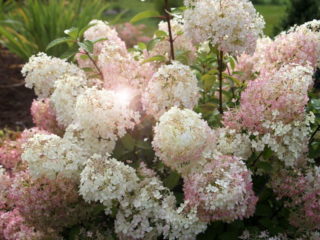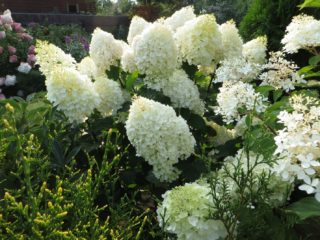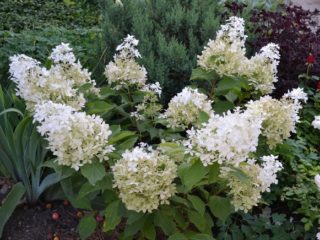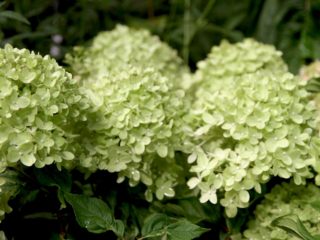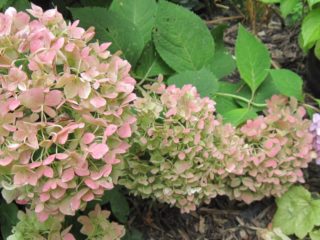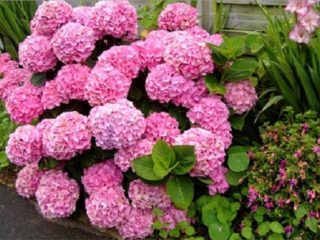Content
Snow-white hydrangea Magical Mont Blanc is a perennial plant with magnificent fluffy inflorescences that form a cone with a greenish tip. This variety is preferred by gardeners around the world, as the plant adapts perfectly to any, even harsh, conditions. Hydrangea blooms profusely all summer, being the main decoration of the summer cottage. The Medical Mont Blanc variety is characterized by increased winter hardiness; the bush can be left for the winter in the garden or taken home to a loggia, balcony or greenhouse.
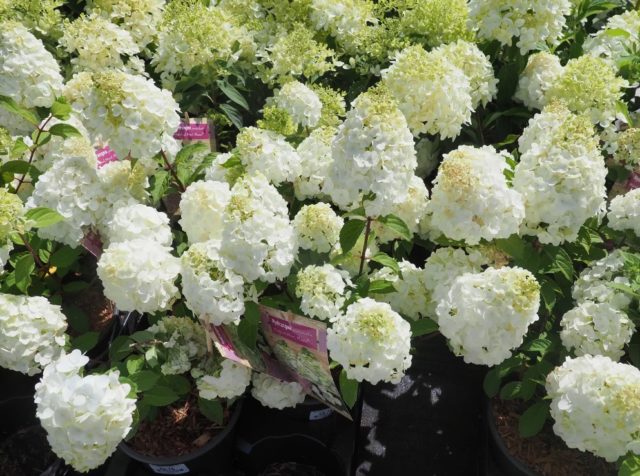
Snow-white hydrangea will decorate a personal plot of any size
Description of hydrangea Magical Mont Blanc
Hydrangea paniculata Magical Mont Blanc is an ornamental shrub with small green leaves of regular shape and large fluffy snow-white inflorescences with a light green crown.The compact and even bush reaches a height of about 120 cm, all shoots are the same length, the inflorescences have a pyramidal shape.
Hydrangea paniculata Mont Blanc in landscape design
Gardeners plant shrubs near high walls, fences and large trees to protect the plant from drafts. Airy snow-white inflorescences decorate the flowerbed, giving a bright accent - both during the flowering period and in the fall, when the leaves of the ornamental shrub acquire bright red shades.
Lush flowers are planted next to spring shrubs - lilac, spirea, mock orange. Medical Mont Blanc replaces faded inflorescences and provides a beautiful look for the flowerbed for the rest of the season.

The inflorescences of Paniculata Medicae Mont Blanc are cone-shaped
Winter hardiness of hydrangea Magical Mont Blanc
This variety of perennial hydrangea is characterized by increased winter hardiness. The shrub is successfully grown even by gardeners in Western Siberia and the Far East. In the European part of Russia, hydrangea can be found even more often. Medical Mont Blanc tolerates even the harshest winters well, provided that the bush is properly cared for and covered in a timely manner.
Planting and caring for Hydrangea paniculata Mont Blanc
You can buy varietal hydrangea seedlings in autumn or spring. After purchasing, it is important to take into account all the nuances of planting and proper care of the plant so that you can admire the gorgeous pyramidal inflorescences of snow-white color all summer long.
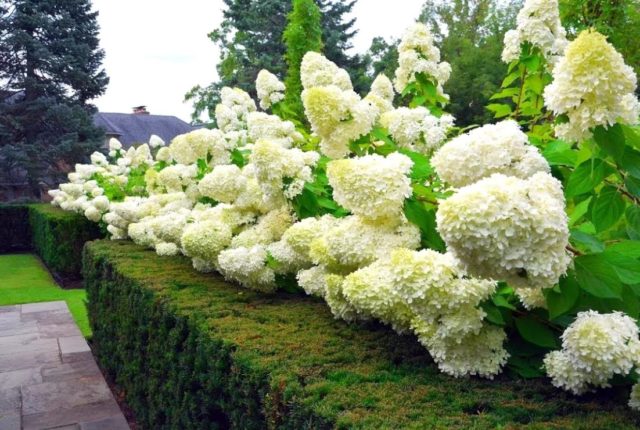
The abundance of flowering depends on proper planting in open ground.
Selection and preparation of a landing site
Paniculata hydrangea loves exclusively fertile soils, neutral, without traces of lime and alkali.In appearance, the small shrub has a powerful root system; the rhizomes extend far from the trunk of the plant, so bulbous flowers should not be planted next to hydrangeas. Frequently digging up the soil for replanting tulips, hyacinths, crocuses or gladioli can damage the roots of the Hydrangea Medical Mont Blanc.
Sawdust, brown peat or pine needles will help neutralize the increased acidity of the soil. You should not plant shrubs in sand or clay. The illumination of the area should be moderate; the plant loves light, but grows well in partial shade. Lack of sunlight can affect the abundance of flowering.
Landing rules
Medical Mont Blanc is planted in spring or autumn. For shrubs, it is necessary to prepare a place with well-drained loamy soil. Dig a wide hole, fill it with water and leave for a day. Next, fill the hole with humus, peat, fertile soil with a portion of sand, add 30 g of urea, superphosphate and potassium sulfate for feeding, mix with loose soil and let it brew for a while.
Before planting, trim the roots of the bush, lower the seedling into the ground, and straighten the root system. Water with water and mulch with humus, pine needles or acidic peat. At first, it is recommended to protect the plant from direct sunlight.
Seedlings planted in the spring will most likely bloom this year. Autumn planting requires careful insulation of the root zone of the plant.
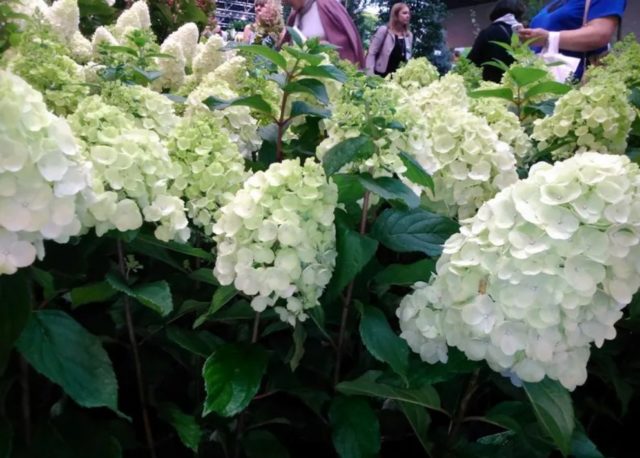
Lush inflorescences decorate the flowerbed and look good when cut
Watering and fertilizing
During the hot season, gardeners need to take care of regular watering of the paniculate hydrangea Medical Mont Blanc. The shrub loves water very much and suffers from dry soil.Water the soil generously once a week and mulch around the trunk in any way.
The plant needs regular feeding. Typically, it is necessary to fertilize paniculate hydrangea in early spring, at the moment of awakening. Organic fertilizers based on mullein or bird droppings are applied to the soil. The next stage of fertilization is carried out in the summer - during the period of budding and active flowering of hydrangea. A solution of potassium sulfate, urea and superphosphate is poured into the root zone. For 10 liters of water, approximately 25-30 g of each substance. The last feeding of the plant for the year is done before the start of winter, when the plant is prepared for hibernation. You can buy a special fertilizer for hydrangeas that does not contain nitrogen compounds.
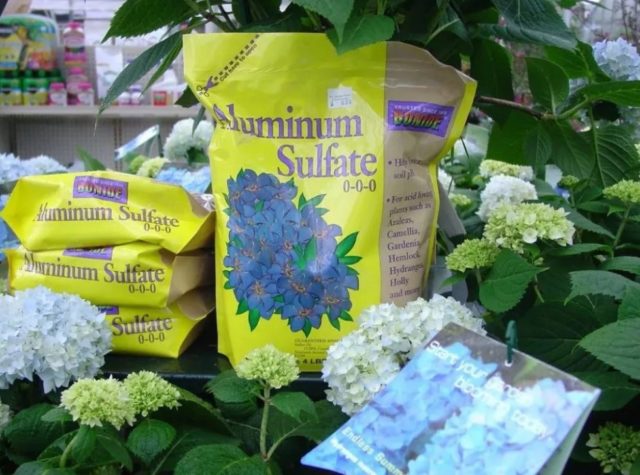
Ready-made fertilizers for abundant flowering must be applied according to schedule
Pruning Hydrangea paniculata Magical Mont Blanc
This is one of the mandatory stages that ensures abundant flowering of the shrub. At the end of March, with the help of pruning, the ideal hydrangea bush is formed. Gardeners leave 7-10 healthy shoots with 3-5 buds. Old plants undergo obligatory pruning; the cut sites usually produce young shoots after a year.
Preparing for winter
Paniculate hydrangea Medical Mont Blanc does not need to be covered for the winter. Varieties of this type of ornamental shrub can withstand frosts down to -35 degrees. Only young hydrangea planted in the fall can suffer from harsh weather. Many gardeners prefer not to even trim dried inflorescences, performing all manipulations with the plant exclusively in early spring.
Reproduction
The most traditional method of propagating paniculate hydrangea Medical Mont Blanc is cuttings. After pruning, the cuttings are not thrown away, but placed in a root solution for several days.Later they are dug in so that 2-3 buds are in the ground. When the first leaves appear, young shoots should be protected from the sun. The paniculate hydrangea bush will be ready for transplanting to a permanent place in 4-5 years.
Diseases and pests
Paniculate hydrangea can resist many diseases and various pests, but prevention is necessary. The main dangers for the Medical Mont Blanc variety are:
- aphid;
- snails;
- spider mite;
- whitewash or gray rot;
- ring spot virus;
- septoria;
- powdery mildew;
- root-knot nematodes;
- transferosis;
- chlorosis.
Acoricidal drugs - acarina, aktar, actellika - help fight pests and diseases. But there are also folk methods of control, for example, gardeners often use garlic to get rid of aphids. It is necessary to pour 250-300 g of cloves with a bucket of water, after a day add 50 g of grated laundry soap. The bush is treated from all sides, trying to evenly distribute the solution over the surface of the trunk. The drug foundationol effectively fights powdery mildew, a common disease of paniculate hydrangeas.
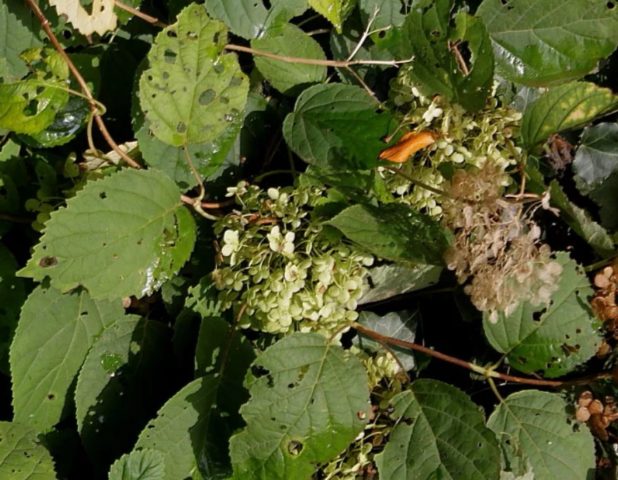
A sick plant loses its attractiveness
Conclusion
Hydrangea Medical Mont Blanc is a rather unpretentious plant. Suitable for both an experienced gardener and a beginner in growing ornamental shrubs. Snow-white inflorescences look impressive when cut; they are often made the accent of a wedding celebration and a bride’s bouquet.

